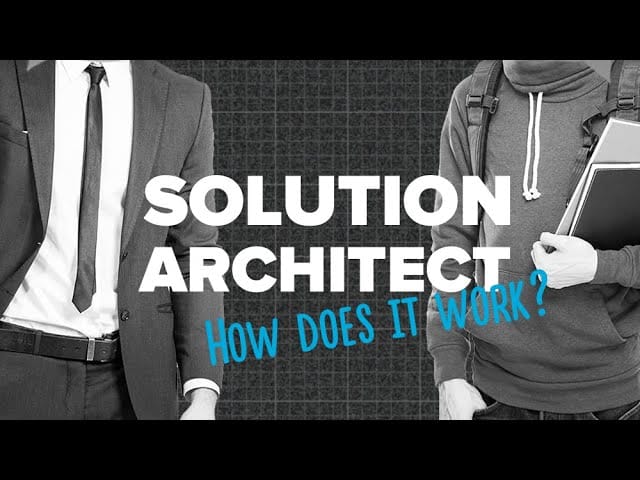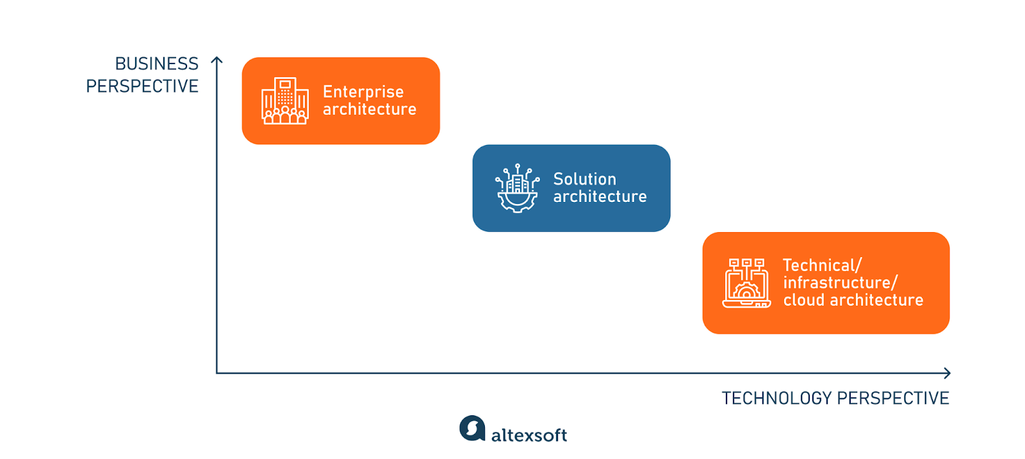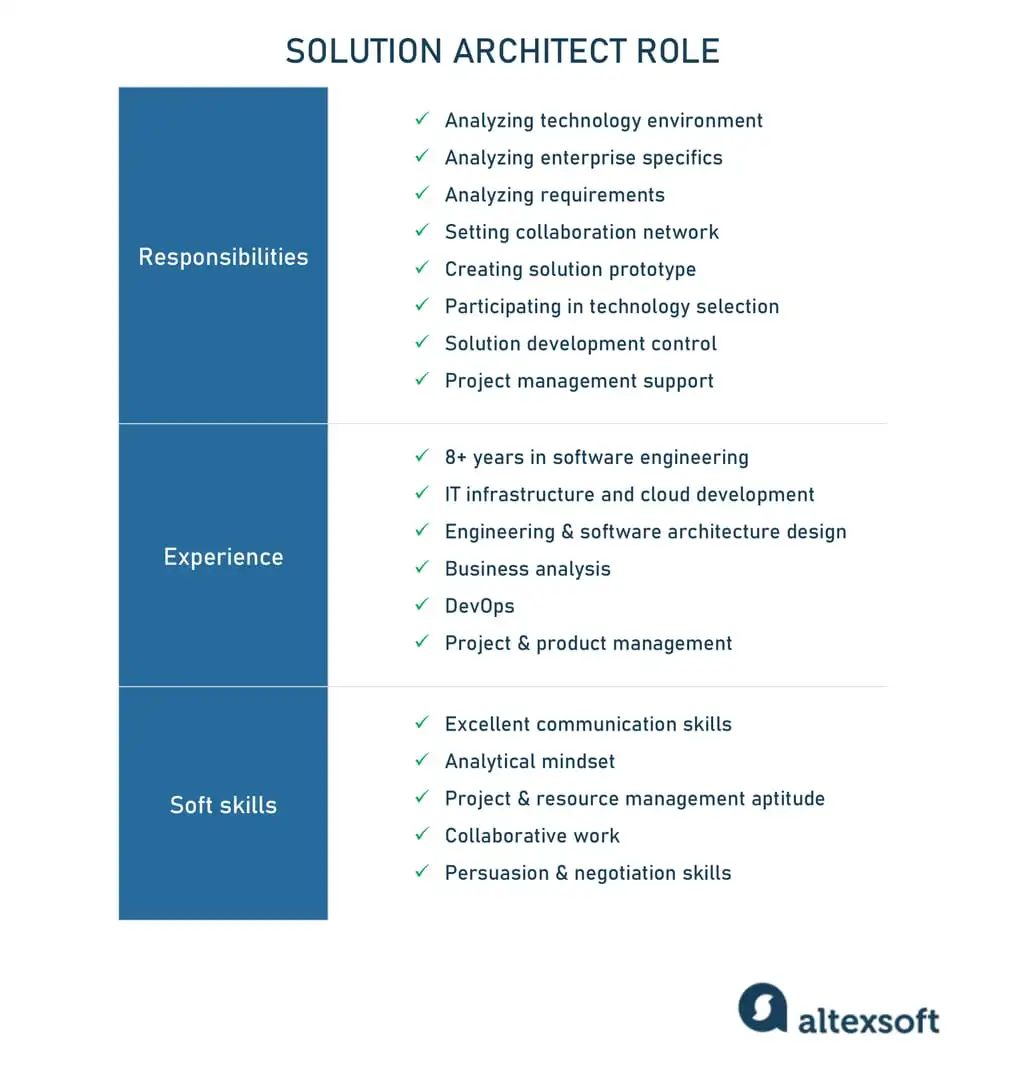In a rapidly changing technology landscape, organizations must transform their processes and systems to meet emerging business requirements. This digital transformation demands specific expertise and a set of practices to align business focus with technological advancements.
Solution architecture belongs to the list of most essential practices executed before any tech solution development begins. In this article, we’ll explain solution architecture and describe the role of a solution architect, clarifying the differences between other architect-level positions. We will also discuss the skillset and required background for a solution architect and explore popular certifications.
What is a solution architect?
A solution architect is an expert in charge of leading the solution architecture — the practice of designing, describing, and managing tech engineering to solve specific business problems. For example, protecting customer data under GDPR and other privacy regulations is a business-level problem. This specialty defines how those requirements would translate into the way a given software operates.


What is a solution architect, and how is this role different from a software architect and enterprise architect? For additional info, subscribe to our channel, as we often release explainer videos.
Among the tasks of solution architects are:
- finding the best tech solution to solve existing business problems;
- describing the software's structure, characteristics, behavior, and other aspects to project stakeholders;
- defining features, development phases, and solution requirements; and
- providing specifications for which the solution is defined, managed, and delivered.
While all those processes can be managed in-house, some companies provide solution architecture consulting as a specific set of services.
Solution architect vs. other architect-level positions
Solution architects are often confused with other architect-level positions. This section will explain the distinctions between enterprise, technical, infrastructure, and cloud architects.
Each role ensures that technology solutions effectively support and enhance overall business objectives, catering to diverse needs and focus areas within IT architecture.

Solution architecture in the context of other architecture areas
Enterprise and solution architecture are more aligned with a business perspective, aiming to understand and address the needs and objectives of an organization. On the other hand, while technical, infrastructure, and cloud architects consider business requirements, they are more tech-oriented.
What is an enterprise architect?
Enterprise architecture focuses on building complex enterprise ecosystems and solving high-level strategic issues. It defines the strategic directions of the business architecture, which then leads to an understanding of what technology facilities are needed to support that architecture. In simpler words, the enterprise architect defines what to do, while the solution architect decides how to do it.
An enterprise architect has the broadest view of the company’s current state of architecture and goals. This expert is responsible for creating a strategic plan for implementing technical changes. Enterprise architects work closely with top-level executives and decision-makers, demonstrating the business value of suggested technical initiatives.
What is a software or technical architect?
Software or technical architect is mainly responsible for engineering problems and software architecture. Unlike the solution architect, the software architect typically doesn’t deal with financial and organizational issues. This role focuses on all aspects of software engineering on a particular project, such as development, implementation, maintenance, support, and evolution.
Software architects closely collaborate with development teams and control the entire development process. So, continuing the previous explanation, the software architect determines what exactly must be done and how to maintain the results.
What is an infrastructure architect?
An infrastructure architect is much like a technical architect but focuses on a corporate on-premises server or cloud systems employed by an organization. An infrastructure specialist helps grow and maintain the production side of a corporate software ecosystem rather than software development itself. These specialists oversee the existing IT systems and networks and explore and integrate new ones, ensuring all standards regarding resilience, security, performance, availability, etc.
Ultimately, technical architects define how the software must be engineered, while infrastructure architects make sure that this software is successfully deployed and operates well. And yet, a technical architect may be responsible for infrastructure as well. So, the lines between these two roles are blurred.
What is a cloud architect?
A cloud architect manages a company's cloud ecosystem, from strategy development and implementation to ongoing optimization and innovation. The components of the cloud architecture include a front-end platform, a back-end platform, a cloud-based delivery model, and a network. Cloud architects’ critical responsibility is ensuring that cloud infrastructure and applications meet the organization's performance, scalability, security, and cost-effectiveness requirements.
Cloud architects design the structure of applications, selecting the appropriate cloud services and resources. They are also responsible for configuring the cloud infrastructure, implementing security measures, and monitoring the performance of applications in the cloud. Additionally, cloud architects can serve as consultants to provide various stakeholders with expertise and guidance on cloud-related matters.
Learn about cloud migration strategy and how to calculate its ROI in our dedicated article.
What does a solution architect do?
Well-built solution architecture helps teams develop the product on time and within budget and ensures that it solves the problem it was designed to address. So, what are the main processes supervised by the solution architect?
Matching solutions with the corporate environment
Usually, companies already have operating systems, an information context, and integration requirements. The solution architecture helps ensure a new system fits the existing enterprise environment. To perform this task, a solution architect must know how all parts of the business model work together, including processes, operating systems, and application architectures. Understanding these aspects, they can design a solution that best fits the environment.
Meeting the requirements of all stakeholders
One of the most critical challenges of software product development is meeting the stakeholders’ requirements. Usually, a product has a number of stakeholders, both technical and non-technical specialists. Solution architecture aims to ensure that all their requirements are taken into account. Stakeholders have to be regularly informed about product development processes, costs, and budgeting. A solution architect usually does these tasks, translating technical project details into a language that management and non-technical stakeholders can understand.
Accounting for project constraints
Each project has its limitations, which are usually referred to as constraints. These include:
- technology,
- risks,
- scope,
- cost,
- quality,
- time, and
- resources.
For instance, a product is built with technologies that must suit the requirements of its particular modules. Project scope is a part of software documentation that defines specific goals, tasks, features, and functions. All projects also have an allocated budget.
While these aspects are constraints in themselves, each has its limitations. The solution architect must understand all these constraints, compare them, and then make technological and managerial decisions to reconcile these restrictions with project goals.
Selecting the project technology stack
A vital part of creating solution architecture is the selection of technologies for product development. The technical architecture strategy will directly depend on the chosen technology stack. There are a lot of different practices associated with platforms, programming languages, and tools. The solution architecture function here is to find the most suitable for a particular project. It’s not an ordinary task requiring technology assessment and comparison.
Compliance with non-functional requirements
All software projects must meet non-functional requirements describing the system's characteristics. These are also known as quality attributes. While the exact list of non-functional requirements depends on the complexity of each product, the most common ones are security, performance, maintainability, scalability, usability, and reliability. The solution architect’s role is to analyze all non-functional requirements and ensure that further product engineering will meet them.
Since we’ve discussed high-level goals of solution architecture adoption, let’s break them down into specific responsibilities and underlying skill sets.
Solution architect job description and responsibilities
The solution architect’s job focuses on solution-level decisions and analysis of their impact on the overall business goals and outcomes. Just like the architect in the construction industry creating a general blueprint of a future building, a person in this position must have a profound knowledge of available technologies to suggest the best solution according to the incoming requirements and existing environment.
The product of a solution architect’s job is the set of technological solutions and their implementation strategy. After developing a strategic technical vision of the product, the solution architect estimates the budget and presents it to the stakeholders. Once everything is agreed upon, they monitor the development process and keep stakeholders informed about the progress.
A solution architect’s responsibilities directly derive from processes in practice:
- analyzing the technology environment,
- analyzing enterprise specifics,
- analyzing and documenting requirements,
- setting the collaboration framework,
- creating a solution prototype,
- participating in technology selection,
- controlling solution development, and
- supporting project management.
While most of these responsibilities require a leadership role from a solution architect, this person just supports PM activities to ensure that resources, risk recognition, and planning stay aligned with the solution goals.
Solution architect skills and resume
If you have already realized the importance of solution architecture in your projects, the next step is to source and hire the person for the role. We’ve considered the core skills that a good solution architect must possess.

Solution architect role breakdown
The following sections will delve into the technical background necessary for a solution architect, as well as their soft and analytical skills and proficiency in project and resource management.
Technical background and experience
To provide management and engineering teams with technical advice, a solution architect must have a background in one or more IT areas, including but not limited to,
- IT architecture, infrastructure, and cloud development;
- engineering and software architecture design;
- business analysis;
- DevOps; and
- project and product management
A minimum of eight years of experience in IT is often a requirement because it ensures that the solution architect has encountered many scenarios, challenges, and projects. It provides a solid practical knowledge and a comprehensive understanding of industry best practices, emerging technologies, and problem-solving strategies.
Excellent communication skills
A vital part of the solution architect’s competence is communication. Considering that this role entails negotiating with stakeholders, understanding the needs of all parties, managing risks, and product delivery, the lack of communication skills can create a real bottleneck. The position requires working closely with enterprise and software architects, business analysts, and project teams. So, an experienced solution architect should be able to listen, advise, empathize, and explain.
Deep analytical skills
Designing a solution requires understanding how different parts of the business work together. The architect must recognize the corporate strategy and realize all business processes that define how a company achieves its strategic goals. However, the architect must also understand tech specifics. As a result, solution architects constantly deal with analytical work and move between various business layers.
Project and resource management skills
While a solution architect doesn’t directly get involved in project management, accounting for deadlines and given resources is inevitable. Solution architects must be able to decide which solutions are advantageous and which are worthless in a given situation. They must be focused on business results and understand how to achieve them according to the given timeframes and resources.
Besides that, solution architects must consider the project from a long-term perspective and understand that the solution might need to scale and adapt to possible changes in the future. So, being the ones who know the ultimate target, they guide the development process accordingly.
Solution architecture examples
Real-world solution architecture examples can vary widely depending on the industry, organization, and specific business needs.
ECommerce platform. A solution architect can lead the development of an eCommerce platform with components such as an application, product catalog, user authentication, payment processing, and order fulfillment systems.
Enterprise Resource Planning (ERP) system. For a large corporation, a solution architect may design an ERP system that integrates finance, human resources, supply chain management, and customer relationship management. The architect ensures seamless data flow and process automation.
Healthcare information system. In the healthcare sector, a solution architect can oversee the creation of an integrated information system that connects electronic health records (EHRs), laboratory information management, billing systems, and patient portals. The architect addresses data privacy and compliance requirements while ensuring accessibility and usability for healthcare professionals and patients.
Online booking systems. Solution architects can design and implement online booking systems that allow travelers to search, compare, and book flights, hotels, rental cars, and other travel services. These systems often involve complex integrations with airline reservation systems, hotel property management systems, and global distribution systems (GDS).
Financial services platform. Banking institutions encompass functions like online banking portals, mobile banking applications, fraud detection, risk management, and regulatory reporting. The architect ensures data integrity and compliance with financial regulations while providing seamless user experiences across multiple channels.
Solution architects tailor technology solutions to meet specific industry requirements, considering scalability, security, interoperability, compliance, and user experience.
Solution architect certification
Certifications validate the skills and expertise of solution architects, assessing their knowledge, abilities, and experience. So, having one or more credentials proves the expert’s proficiency in specific skills.
Besides the exam, most certification platforms offer training courses, learning materials, and practice tests. Other resources can also help prepare and practice, such as Udemy, Coursera, or MeasureUp. However, you can take the exam without previous preparation — all required is deep knowledge of the architecture concepts and principles and vast hands-on experience in the industry.
There are a lot of IT architect certifications available, with most being vendor-specific, i.e., focused on mastering a specific technology. Here’s a brief overview of the most popular ones.
AWS Solution Architect certification
The AWS Certified Solutions Architect program offers certifications at associate and professional levels, depending on your experience. Both target architects who work with AWS technologies to build and deploy applications and systems.
The AWS Certified Solutions Architect Associate exam has 65 questions, takes 130 minutes, and costs $150. Amazon recommends candidates have at least one year of hands-on experience before taking the test. Here’s a list of the content domains of this exam:
- Domain 1: Design Secure Architectures (30 percent of scored content)
- Domain 2: Design Resilient Architectures (26 percent of scored content)
- Domain 3: Design High-Performing Architectures (24 percent of scored content)
- Domain 4: Design Cost-Optimized Architectures (20 percent of scored content)
Check out the exam guide to learn more details about each domain.
The AWS Certified Solutions Architect Professional exam is for senior architects with two or more years of experience and an associate credential. It has 75 questions, takes 180 minutes to complete, and costs $300. Here’s a content outline:
- Domain 1: Design Solutions for Organizational Complexity (26 percent of scored content)
- Domain 2: Design for New Solutions (29 percent of scored content)
- Domain 3: Continuous Improvement for Existing Solutions (25 percent of scored content)
- Domain 4: Accelerate Workload Migration and Modernization (20 percent of scored content)
For a comprehensive description, visit the exam guide.
AWS certifications are valid for three years, after which the credential holders must undergo recertification to prove their continued expertise and knowledge of the latest AWS technologies and best practices.
Azure Solution Architect certification
Microsoft has a variety of credentials for solution architects, the most well-known being the Microsoft Certified: Azure Solutions Architect Expert. This one is for candidates who specialize in solutions that run on Microsoft Azure and have advanced knowledge of Azure infrastructure.
Here’s an overview of the skills measured by these tests. In a nutshell, AZ-305 focuses on technical tasks, such as:
- implement and monitor an Azure infrastructure,
- implement management and security solutions,
- implement solutions for apps, and
- implement and manage data platforms.
The content of AZ-305 is assessing such skills as:
- design monitoring,
- design identity and security,
- design data storage,
- design business continuity, and
- design infrastructure.
The Azure Solutions Architect Expert certification can be obtained after taking the AZ-305: Designing Microsoft Azure Infrastructure Solutions exam. The price depends on the country where the exam is proctored ($165 for the United States).
ITIL certification
ITIL is the industry-recognized set of qualifications that includes five levels. The highest credential is the ITIL Master, which is for IT service management professionals with extensive experience with ITIL practices. It’s not a role-based certification specifically for solution architects. Still, since ITIL is a popular management framework, the person who mastered its principles would be a valuable asset in any managerial position.
The description states that to be certified, you must be able to “explain and justify how you have personally selected and applied a range of knowledge, principles, methods, and techniques from the ITIL Framework and supporting management techniques to achieve desired business outcomes in one or more practical assignments.” So, this exam has no training course or fixed syllabus since it evaluates every candidate within their unique range of experience.
The ITIL Expert certificate is a prerequisite for gaining this credential. The candidate must also have over five years of experience in leadership, managerial, or high-level advisory roles. Once these conditions are fulfilled, the hopeful will have to register with PeopleCert (the approved Axelos Examination Institute), fill out the application, and present their CV.
Next, the proposal for a business improvement has to be submitted with the work package showing the candidate’s practical skills in applying the ITIL principles in real-world business cases. After that, the applicants will have to successfully pass an interview with an assessment panel where they will be answering questions about their experience.
The costs of ITIL exams vary based on factors such as the level of certification, geographic location, exam delivery method, and the exam provider.
Google Cloud Architect certification
Google also offers several role-based certifications. Professional Cloud Architect is the one for experts who use Google Cloud technologies in their solutions. It’s not only for solution architects but for any professional in Google Cloud architecture. The exam guide (as well as learning materials and sample questions) is available and lists six aspects of the exam:
- Designing and planning a cloud solution architecture;
- Managing and provisioning a solution infrastructure;
- Designing for security and compliance;
- Analyzing and optimizing technology and business processes;
- Managing implementations of cloud architecture; and
- Ensuring solution and operations reliability.
The exam is 2 hours long with a registration fee of $200. Google recommends at least three years of industry experience before taking the test, including at least one year of experience designing and managing solutions using Google Cloud. It’s also important to remember that recertification is required every two years.
SAP Solution Architect certification
The SAP Certified Application Associate - Customer Experience Solution Architect exam validates the candidate’s knowledge and understanding of the features and architecture of SAP Customer Experience Solutions and SAP BTP. These skills allow you to perform or provide guidance on various implementation, customization, and maintenance-related tasks within a project team.
This examination has 80 questions, takes up to 180 minutes, and costs $219 for one attempt or $547 for six attempts. It is for solution architects with two or more years of hands-on experience implementing SAP Customer Experience solutions.
Here is the list of topics covered, with percentages indicating the relative weight of each exam topic:
- SAP Extension Suite (>12 percent)
- SAP Integration Suite (>12 percent)
- SAP Sales and Service Cloud (>12 percent)
- SAP Customer Data Cloud (8-12 percent)
- SAP Commerce Cloud (8-12 percent)
- SAP Marketing Cloud and Emarsys (8-12 percent)
- The Intelligent Enterprise (8-12 percent)
SAP recommends its courses (listed here under the topic areas) to prepare for the certification exam. During the test, you are not allowed to use reference materials like online documentation or any SAP system.
When a company needs solution architecture consulting
Technology consulting organizations can introduce solution architecture to the corporate structure if the integration of new software systems isn’t systematic. On top of that, there is no need to have a solution architect for every single project. If you implement a single tech module that is proven to be working in similar contexts, you don’t need a solution architect.
Once software engineering projects grow more complicated and entail more processes and risks, it’s better to consider solution architecture consulting services. Let’s have a look at the cases when solution architecture consulting is recommended:
You don’t know which solution fits the enterprise ecosystem best. You need to link the existing enterprise architecture and the particular project. Solution architects will guarantee the solution meets the standards of your company environment. For example, suppose you move existing back-office processes to the cloud. In that case, a solution architect analyzes multiple options and suggests the most relevant ones regarding technology, human, and financial resources.
You run a digital transformation project. Digital transformation requires businesses to reconsider how they deliver value to their customers or what they will eventually deliver. There’s no way to answer these questions without linking technology and business perspectives, which is squarely in a solution architect’s wheelhouse.
You face a lot of risks. A solution architect is necessary for projects where many technology risks are present, uncertain requirements can appear, multiple products must be implemented at once, or the underlying technologies aren’t approved yet.
You must pitch a product roadmap to investors. If you must present a future product to investors and stakeholders, a solution architect will suggest the technologies that will match product requirements and communicate the reasoning in plain and clear business terms.
You need to set up communications between stakeholders and engineers. A solution architect will help fill the communication gap between technical and non-technical specialists. Also, by collaborating with the project management team, solution architects cover the risks of product misalignment with stakeholder requirements and ensure that the solution fits the defined purpose.
Many teams are involved in the project. You may have a large project that requires someone to manage designers and technical or business architect teams to produce a quality technical project outcome.
By deliberately introducing solution architecture, you build the framework that aligns technology, resources, and skills with defined business goals. Before considering solution architecture, we recommend exploring enterprise architecture frameworks that combine both solution and enterprise levels.
Traditionally, small and mid-size businesses consider neither the practice of solution architecture nor the respective role justified. Addressing solution architecture problems is delegated and shared across other roles within a product team. And it’s a viable option for small projects with predictable outcomes.
However, it is crucial to have a dedicated specialist in cases where you have a complex enterprise architecture that introduces multiple software products into a functioning ecosystem and you need to rebuild your legacy software fully or make a set of strategic technological decisions.

